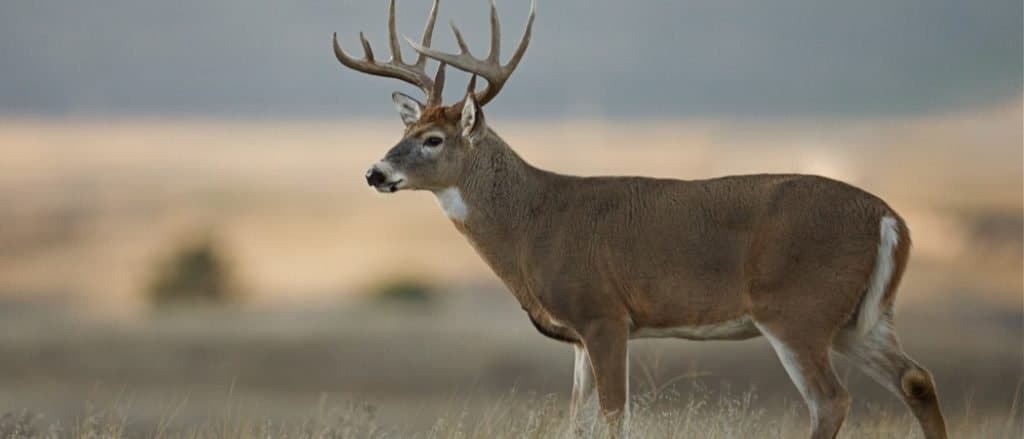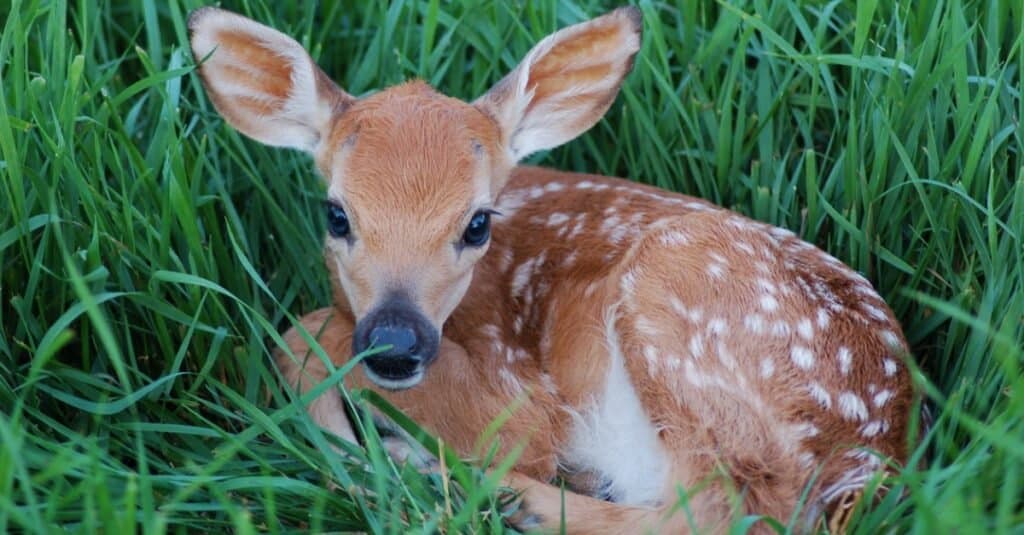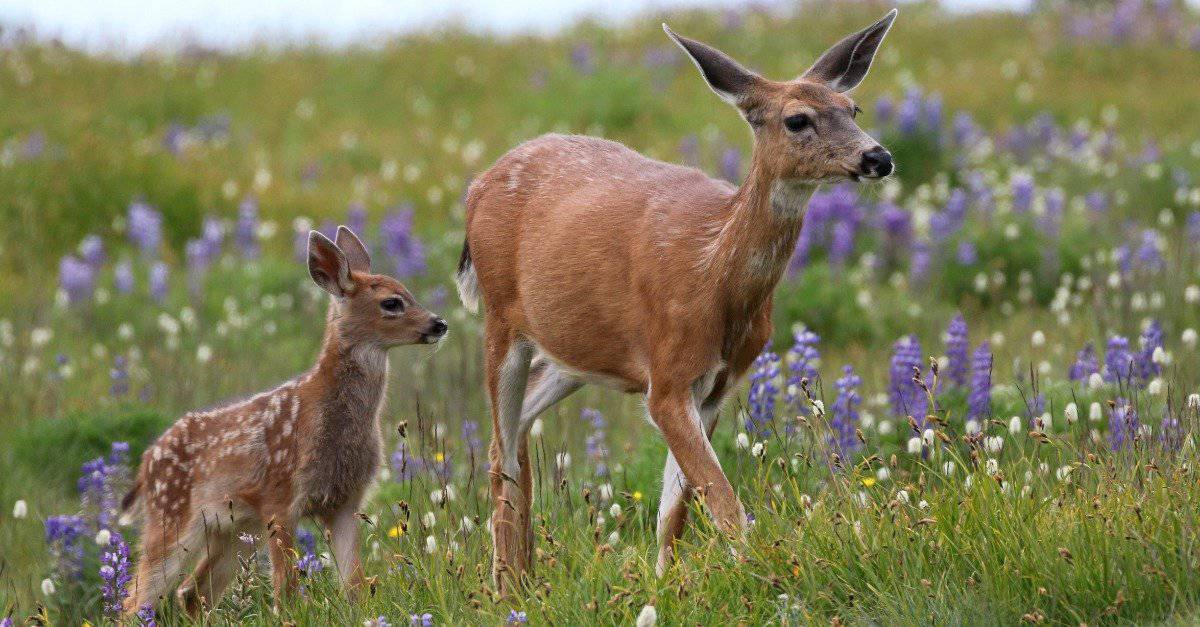Big game lovers would fancy the idea of deer hunting in Ohio. However, hunters have to know the laws that guide the deer season to get prepared for hunting. In this article, we will discover when the deer season opens, license requirements, and regulations in Ohio.
When is Deer Season Open in Ohio?

Each season type has specific dates.
©Tom Reichner/Shutterstock.com
Deer season in Ohio is open in the Fall from late September to early January. The season is split into four different types, each with specific dates and regulations. The specific dates for each season type may vary depending on the year, as the opening day will always be a Saturday. The bag limits for bucks and does depend on which county you are hunting in.
Before hunting review the current Ohio Department of Natural Resources (DNR) requirements for licenses, permits, maps, and the rules and regulations for deer hunting.
Hunting License Requirements
Everyone that wishes to hunt in the state of Ohio is required to obtain a hunting license. These can be purchased on the Ohio DNR’s website, the HuntFish OH mobile app, or at authorized agents (typically sporting goods and hunting supply retailers). If you do not live in Ohio and would like to travel to Ohio to hunt, you must purchase an Ohio Non-Resident Hunting License; a hunting license from your home state is not valid.
Ohio has multi-year license options for residents; you can purchase 3-, 5-, and 10-year licenses for a lower cost than buying a one-year license every year. A lifetime license is also available and is currently a better deal if you plan to hunt for more than 24 years. Discounted licenses for seniors are also available.
All first-time hunting license buyers must complete a hunter education course before purchasing a license. There are two exceptions to this rule: you can buy an apprentice license, or if you have completed a hunter education course from another state, you can provide proof and do not have to take the course in Ohio.
An apprentice license allows you to hunt without taking the course. However, you must be accompanied by a licensed adult 21 years of age or older, and they must stay with you while you hunt. The Hunter Education course is available in a classroom setting or as an online course.
Permits
To deer hunt in Ohio, you also must purchase a permit. This can be either an “Either-Sex Deer Permit” or a “Deer Management Permit.” These permits have resident, nonresident, youth, and senior options.
Either-Sex permits are valid statewide and may be used during any of the deer seasons. They are suitable for an antlered or an antlerless deer. The Deer Management permits may be used to take antlerless deer. They are valid only on private land and are only good for the first part of the season, typically from the opening day of the Archery season until the opening day of gun season.
There are also special controlled deer hunts in areas that are generally not open to hunting. These require the hunter to apply for them during July, and a random computer drawing selects a certain number of hunters. Any deer taken during a controlled hunt does not count toward your bag limit.
Deer Season Types

There are four deer season types in Ohio.
©iStock.com/tmphoto98
Ohio has four basic deer season types: Archery, Youth Gun, Gun, and Muzzleloader. Archery season typically starts on the fourth Saturday in September and continues through early February. Youth Gun season is typically the weekend before Thanksgiving.
Gun Season is usually open for one week after Thanksgiving and one weekend before Christmas. Muzzleloader season is open for four days, beginning the first whole weekend in January.
As you can see, the gun seasons in Ohio are limited, while the Archery season allows over four months of uninterrupted hunting.
Season Type Regulations
Hunters must use approved hunting devices during the four different deer seasons. Specifics of these seasons are listed here:
Archery Season
Hunters may use archery devices this season, such as compound bows, longbows, recurve bows, and crossbows. The minimum draw weight for bows is 40 pounds, and the arrows must have broadheads with at least two cutting edges and a minimum diameter of ¾” of an inch. Expandable and Mechanical broadheads are allowed.
The minimum draw weight of crossbows is 75 pounds, and the exact arrow requirements as bows apply. No firearms may be used during this season.
Youth Gun Season
This season is open to anyone 17 years of age or younger during the season dates. All hunters must be accompanied by a non-hunting adult who is 18 years of age or older.
The adult must be close by and have “uninterrupted, unaided visual and auditory communications.” Up to two youths may hunt with each adult. The youth may use archery, gun, or muzzleloader devices as described in the other seasons.
Gun Season
Firearms used during the gun season include rifles, handguns, shotguns, and muzzleloaders. Rifles must use straight-walled cartridges from a minimum of .357 caliber to a maximum of .50 caliber. Cartridges with a necked-down shoulder are not allowed.
Shotguns must be ten gauge or smaller and use ammunition that fires only one ball or one rifled slug.
Both rifles and shotguns can be loaded with no more than three cartridges or shells in the chamber and magazine combined. Handguns must have a minimum barrel length of 5 inches and use straight-walled cartridges .357 caliber or larger. Muzzleloaders may also be used during gun season, as described below.
Muzzleloader Season
Muzzleloaders include firearms that require the firing components (projectile and powder) to be loaded from the barrel’s muzzle (front) end. They must not allow loading the components from the barrel’s breech (rear) end. Muzzleloading Rifles may be used that are at least .38 caliber or larger.
Muzzleloading shotguns that are 10 gauge or larger may be used and fire only one ball per barrel. Modern firearms that use cartridges and muzzleloading handguns may not be used during this season.
Regulations and Safety Information

Using dogs to hunt deer in Ohio is not allowed.
©iStock.com/nearandfar
There are some essential regulations to keep in mind. The items below are by no means a complete list, be sure to review and understand the Ohio DNR hunting guide and regulations before going on your first hunt in Ohio.
- Bag limits for Ohio depend on the county you are hunting in. Some counties allow two deer to be harvested, some allow three, and a few allow four. Once you reach your bag limit in one county, you can hunt in a different county but must never exceed the statewide bag limit of six total deer. In all cases, only one deer may be antlered, and you may never exceed a county bag limit or the state bag limit.
- Hunting hours are restricted to 30 minutes before sunrise until 30 minutes after sunset.
- Hunting from a motor vehicle is prohibited. It is also not allowed to shoot from, on, or across a public roadway, highway, shoulder, or right-of-way.
- During Youth deer gun season, deer gun seasons, and the deer muzzleloader season, hunters must wear a vest, coat, jacket, or coveralls that are either solid hunter orange or camouflage hunter orange. The garment must be visible from the front and the back, so ensure you do not carry a backpack that could obscure the garment from the back.
- In Ohio, an antlered deer is defined as a deer with at least one antler at least 3 inches long.
- Possession of ammunition for a firearm that is not allowed is prohibited. During muzzleloader season, you may not possess rifle ammunition, for example, while hunting. Check your hunting gear and your coat or vest to ensure you do not have any leftover cartridges from last year’s season.
- Using dogs to hunt deer is not allowed in Ohio. Do not attempt to take a deer that may be running from dogs, even if the dogs are not yours. Be patient and wait on the next opportunity, as you could be breaking the law.
- Using salt, grain, or any other type of feed to lure, attract, or entice deer to a particular area and then hunt near that area is not allowed.
- While hunting on public land, using nails, screws, or other items inserted into trees for climbing or holding a tree stand is not allowed.
Safety Guidelines
When firearms or even archery equipment is involved, safety should always be in the front of a hunter’s mind. Handle your weapon with respect, be sure of your target, and, just as important, what is beyond your target. Make sure you are taking a deer and if it is antlered or antlerless before taking a shot. Make sure of what is beyond your target deer; a building, other hunters, or another deer should not be hit if you miss. It would not be good to take too many antlered deer in a season just because you misplaced a shot.
If you are using a tree stand, make sure to use a safety strap to prevent a nasty fall in case you lose your balance. A common misconception is that most hunting accidents are from hunters accidentally getting shot by another hunter. More injuries occur from hunters falling out of tree stands.
Chronic Wasting Disease Concerns in Ohio
Chronic Wasting Disease (CWD) is a fatal neurological disease affecting the Cervid family of deer, including Elk and Moose. CWD has been detected in Ohio and the surrounding states. The main symptoms are that the deer appears very thin and sick, may have difficulty moving, and appear confused, nervous, and unaware of its surroundings.
Several CWD-positive deer have been harvested in Wyandot and Marion counties in Ohio.
The Ohio DNR established a Disease Surveillance Area in 2021 and expanded it in 2022 to include all Wyandot, Hardin, and Marion counties. The DSA requires mandatory testing for all deer harvested during specific dates and the entire seven-day gun season, as noted in the hunting guide. There are Kiosks where hunters can deposit deer for testing throughout the DSA. The locations and dates of operations are updated at www.wildohio.gov.
Preventing the Spread of CWD
To prevent the spread of CWD, ensure you properly dispose of your deer carcass.
Be sure to double bag all the high-risk parts, such as the brain, spinal cord, eyes, and lymphoid tissues, and dispose of them with your household trash to take them to a landfill.
It is illegal to bring these high-risk carcass parts into Ohio from outside of the state or remove the high-risk parts from the DSA counties unless you are taking a deer carcass to an Ohio Division of Wildlife certified processor or taxidermist within 24 hours.
While CWD has not been found to affect humans, you should still take the proper precautions when handling a suspected CWD-positive deer. Many deer harvested and tested positive were not showing any symptoms.
Wear rubber gloves when field-dressing and butchering, and thoroughly wash all of your instruments afterward. Bone out the meat, minimize the handling of the high-risk parts, and certainly do not eat any deer’s brain, spinal cord, eyes, spleen, tonsils, or lymph nodes. Finally, do not consume meat from any animal that tests positive for CWD.
What to do After a Deer is Harvested?
Immediately after a deer is harvested, fill in your deer permit with the kill’s date, time, and county. The deer may then be field dressed and transported. You must then complete the game check process before noon of the following day and before you leave your deer unattended.
The game check process can be done by phone, at www.ohiogamecheck.com, on the HuntFish OH mobile app, or by visiting any authorized license sales agent. Once you answer a series of questions during check-in, you will be issued a confirmation code. This code is your proof that the game check process has been completed.
The confirmation code must be noted on the permit or tag. Attach it to the deer before taking it to a processor or taxidermist. The code should remain attached to the deer and its parts. Furthermore, you must write it on the back or bottom of any mount.
Fines for Not Following Regulations
Illegally taking deer in Ohio can result in hefty fines, loss of hunting privileges, and even jail time. Court and lawyer fees can also be costly, even if you are acquitted.
In 2019, a man was convicted of providing false information while game-checking. He harvested more than one antlered deer than allowed during that season. He was fined $27,000 and was stripped of his hunting rights for one year.
Ohio is a member of the Wildlife Violators compact. If you lose your hunting rights in one of the member states, you could also lose them in 46 other states. Be sure you review and understand all the hunting regulations and license requirements before hunting deer in Ohio.
Up Next
Thank you for reading! Have some feedback for us? Contact the AZ Animals editorial team.








